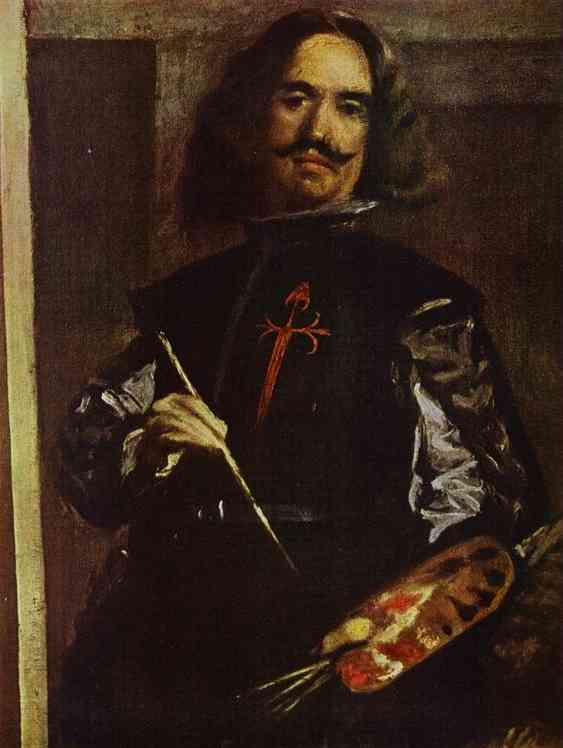The directory «Artists»
Velázquez Diego Rodríguez de Silva y
(1599–1660)

He was the most celebrated painter of the Spanish school. At 11 he was apprenticed to Francisco de Herrera the elder, whom he soon left for the studio of Pacheco, where he remained for five years. There he came into contact with the most intellectual society of Seville and with the work of the Spanish naturalist painters and the great Italian masters. His earliest paintings, such as Christ and the Pilgrims of Emmaus (Metropolitan Mus.), show great vigor and a strong naturalistic point of view. In 1618 Velázquez married Pacheco’s daughter Juana, and five years later moved to Madrid.
Under the protection of the condé de Olivares, Velázquez was introduced to the court and painted an equestrian portrait of Philip IV (later destroyed), which won him immediate recognition. At 25 he was made court painter and given a studio in the royal palace. During his first years at court Velázquez painted the portrait of Olivares (Hispanic Society, New York City) and full-length portraits of Philip IV and Don Carlos, a bust portrait of Philip IV, and the celebrated Borrachos [the drunkards] (all: Prado). In 1629, shortly after a visit by Rubens to the Spanish court, Velázquez made his first visit to Italy, returning in 1631. During his stay he copied some works of Tintoretto and painted two large figure compositions, The Forge of Vulcan (Prado) and Joseph’s Coat (Escorial).
To his second period (1631–49) belong the great equestrian portraits of Olivares and the king, Christ on the Cross, the magnificent Surrender of Breda, the series of dwarfs and buffoons of the court, the Aesop, the Menippus (all: Prado), and the three-quarter-length portrait of Philip IV (Frick Coll., New York City). To the 1640s belong the Coronation of the Virgin, St. Anthony the Abbot and St. Paul the Hermit, the famous full-length portraits of Mariana of Austria (Philip’s second wife), and the Infanta Margarita, The Spinners (also known as the Fable of Arachne), and Las Meninas (all: Prado). Also of this period are the head of the Infanta (Louvre) and the portrait of Philip IV as an old man.
In 1649 Velázquez paid a second visit to Italy to buy statues and paintings for the king and returned two years later, having enriched the Spanish royal collection by many Italian masterpieces. While in Italy he painted the superb portrait of Pope Innocent X (Doria Palace) and two small, exquisite landscapes of the Villa Medici gardens (Prado). His only nude, Venus and Cupid—also called the Rokeby Venus—(c.1650; National Gall., London) exemplifies his moral view of mythology, emphasizing the vanity of the goddess.
Throughout his career Velázquez enjoyed the close friendship of the king; he was made marshal of the palace and administrator of the royal galleries. His duties often interfered with his freedom to paint. He died shortly after organizing the marriage ceremonies of Marie Thérèse of Austria to Louis XIV.
Velázquez’s development as an artist was uncommonly steady. His first forms were monumental and powerful, enveloped in a strong chiaroscuro. The artist slowly evolved an extraordinarily subtle art based on exquisite color values, of which he remains the unrivaled master. His cool palette and consummate use of silver tones in conjunction with brilliant color sometimes recall El Greco. In spirit, however, Velázquez is far removed from the art of El Greco due to his worldliness and compassion for all levels of humanity. He imbued all human beings from dwarfs to kings with a sense of dignity and individual worth.
Velázquez had many followers. His son-in-law Mazo imitated his portrait style so successfully that many works now thought to be his were formerly attributed to Velázquez. But in his great works Velázquez has never been successfully imitated. His mature works are very few—some say not more than 100. He was obliged to produce replicas of many of his court portraits. Some of these were executed by Mazo, and all are inferior to the originals. Velázquez can be fully appreciated only in Madrid, although more or less authentic examples of his work are to be seen in many galleries in Europe and the United States.
Spain, 1945, Gomes de Quevedo
Spain, 1959, Aesop by Velazquez
Spain, 1961, Luis de Góngora y Argote
Spain, 1961, Luis de Góngora y Argote
Spanish Sahara, 1960, Francisko Gomes de Quevedo
Spanish Sahara, 1960, Francisko Gomes de Quevedo